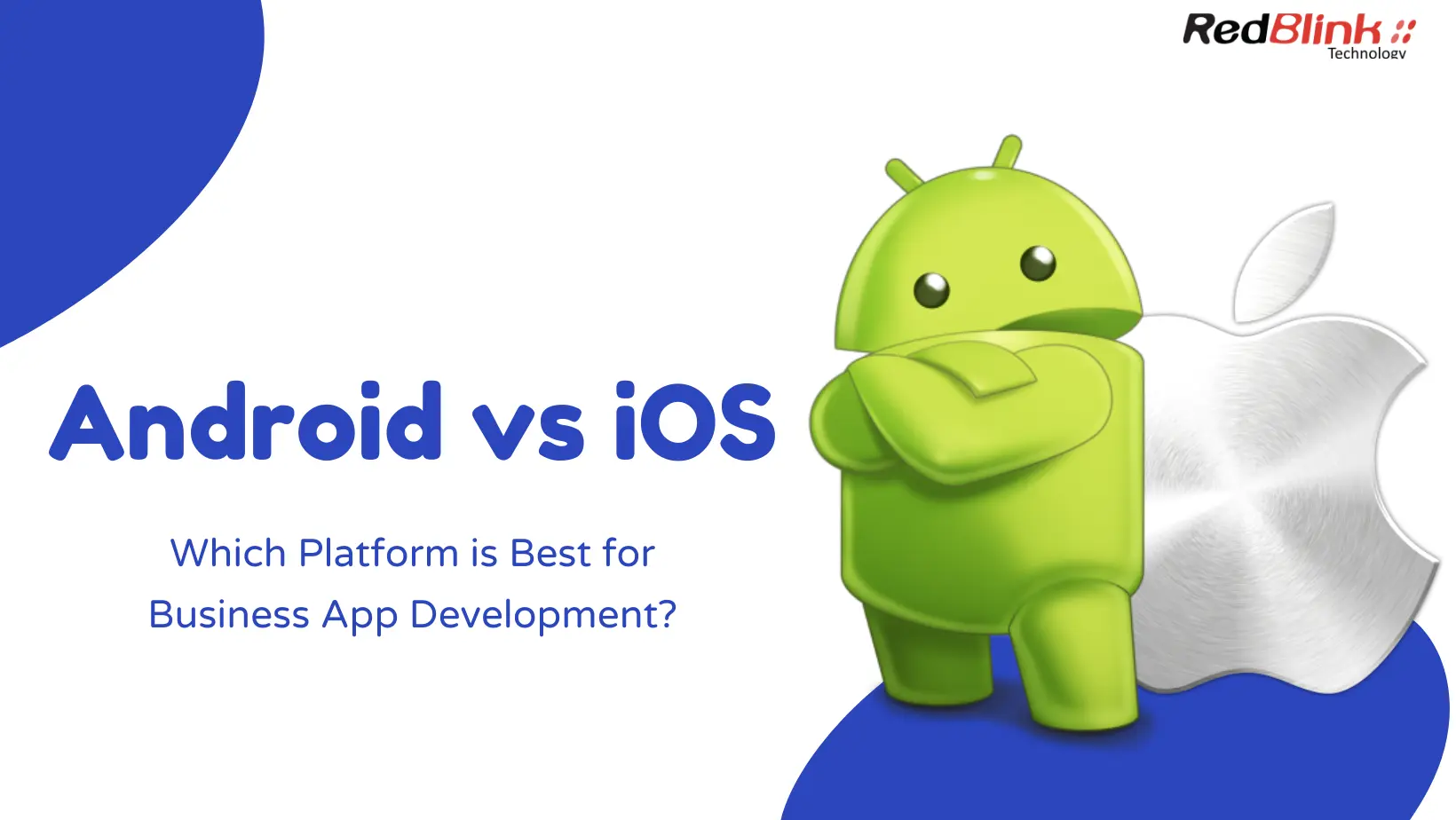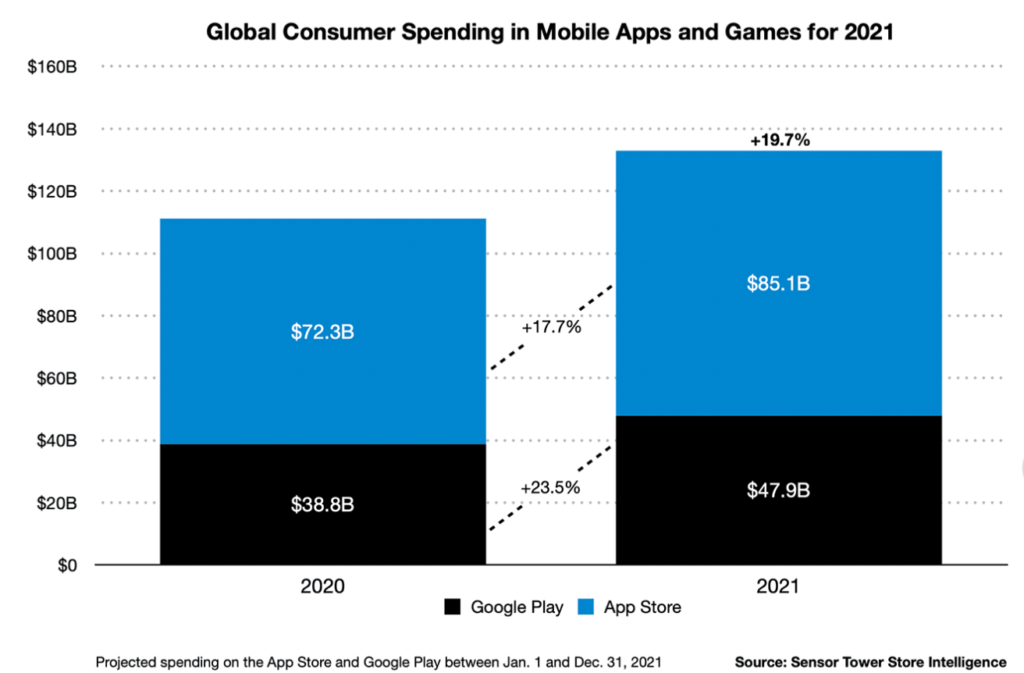Android vs iOS App Development
Have you ever wondered – Which platform will be better for business app development, Android or iOS?
Absolutely! It’s a crucial decision for businesses developing a mobile app. Android and iOS are dominant players in the mobile operating system market, each with its strengths and weaknesses.

Android OS, developed by Google, has the largest global market share and offers customization and flexibility due to its open-source nature. iOS, developed by Apple, is known for delivering a premium user experience and a curated app marketplace.
But, it’s also worth considering that Android devices come in various models and price points, catering to a broader demographic. This diversity provides businesses with a larger potential user base, especially in emerging markets where affordability plays a significant role.
And, iOS devices, on the other hand, maintain a loyal customer base, known for their higher average income and spending power. This can be advantageous for businesses targeting a specific niche or looking to create a seamless, high-end user experience.
So, when choosing between Android and iOS, businesses should evaluate their target audience, app requirements, and business goals, considering factors like market share, device fragmentation, revenue potential, and development complexity.
Ultimately, the platform choice should align with the business’s objectives, user preferences, and budget, as a well-executed app can enhance brand visibility, engage customers, and drive revenue growth.
By understanding each platform, businesses can make informed decisions and develop successful, user-centric mobile apps. So, let’s explore the key factors in more detail when choosing between Android and iOS for app development.
Contents
- Android vs iOS App Development
- iOS VS Android Business App Development Comparison: Its Statistics
- A Detailed Overview Of Android and iOS Platforms
- Factors to Consider in Business Mobile App Development
- The Cost and Time of Development
- Ecosystem Control and Fragmentation
- Android vs iOS App Development – Comparison
- Android vs iOS App Development: Which One To Choose?
- When to Choose Android App?
- When to Choose iOS App?
- Still Can’t Decide?
iOS VS Android Business App Development Comparison: Its Statistics
Android and iOS are the two dominant smartphone operating systems (OS) in the market. An OS serves as the interface that connects hardware and software, facilitating seamless user experiences.
-
Popularity and Revenue Generation
When comparing Android and iOS app development, it’s essential to consider their popularity and revenue generation statistics.
-
- According to Business of Apps, as of 2022, iOS, despite holding less than 15 percent of the total market share, leads in revenue generation for app development. This is because of the popularity of Apple phones (iPhones) in high-income regions such as Japan and the US, where iOS users have more spending capabilities.
- On the other hand, Android’s largest markets are in India, Southeast America, and Southeast Asia, which results in lower revenue per user compared to iOS.
- In 2021, the combined app monetization of Android and iOS reached $133 billion, marking a 19.7 % Y/Y increase. Globally, consumer spending on the App Store will reach $85.1 billion, up 17.7 percent Y/Y from $72.3 billion in 2020.
- Although users have spent less on Google Play, that platform will see more Y/Y growth, climbing 23.5 percent to $47.9 billion from $38.8 billion.

Image source: sensortower.com
-
- Although Android has experienced a 167 % revenue increase over the last 4 years, it still falls behind Apple’s app store in terms of total yearly revenue.
-
App Market Growth and Subscription Revenue
-
- In 2021, U.S. consumers spent a total of $40.7 billion on in-app purchases, with approximately 21 percent of that amount being attributed to the top subscription apps. This marks an increase of over 3 percentage points compared to 2020 when the top subscription apps accounted for $5.9 billion or roughly 17.9 percent of the overall spend of $33 billion.
-
- While Google Play generates less revenue compared to iOS, the overall Android ecosystem has been consistently growing each year.
-
Consumer Age Preference
-
- According to a December 2021 survey in the United States, 58 percent of smartphone users aged 18 to 34 preferred iPhones, while 53 percent of those aged 35 to 54 preferred Android phones like Samsung or Google smartphones.
Hence, these factors can help businesses gain insight into Android and iOS’ popularity and revenue potential, assisting them in making informed app development decisions.
A Detailed Overview Of Android and iOS Platforms
Here are the following detailed differences between both platforms. Take a look:
Android Platform
The Android platform is known for its versatility and customization options. Key features and characteristics of the Android platform include:
- Versatility: Android is an open-source platform, allowing developers to customize and modify the operating system according to their needs. This flexibility enables the creation of diverse and innovative apps.
- Wide Market Share: Android holds the largest market share globally, making it a popular choice for app developers. Its presence spans across various devices, including smartphones, tablets, and smart TVs.
- Large User Base: The wide market share translates into a large user base for Android. The platform appeals to a broad demographic, from budget-conscious users to those seeking high-end devices, providing developers with a vast audience to target.
iOS Platform
The iOS platform is known for its sleek design and seamless user experience. Key features and characteristics of the iOS platform include:
- User-Friendly Interface: iOS is recognized for its intuitive and user-friendly interface, making it easy for users to navigate and interact with apps. The platform prioritizes simplicity and consistency in design.
- Quality Control: Apple has stringent quality control measures in place, resulting in a more curated app marketplace. This ensures that apps on iOS devices meet certain standards of performance, security, and user experience.
- Loyal User Base: iOS devices maintain a loyal customer base, with users often willing to spend more on apps and in-app purchases. This demographic is typically associated with higher average income and spending power, making iOS an attractive platform for businesses targeting specific niches or premium experiences.
Businesses can make informed decisions when developing apps and reaching their target audience by understanding the key features, characteristics, and market share of both Android and iOS platforms.
Factors to Consider in Business Mobile App Development
In today’s digital era, mobile apps have become an integral part of any business strategy. However, developing a successful app requires careful planning and consideration of various aspects.
In this comprehensive guide, we will delve into the key factors that play a significant role in business mobile app development.
-
User Base and Market Reach
Understanding your target audience and their preferences is essential for developing an app that resonates with them. Analyzing user demographics, geographical distribution, and user behavior can help determine the platforms (Android, iOS, or both) that are most relevant to your target audience.
TechCrunch reports that the average price of in-app purchases on the App Store has risen by 40% from July 2021 to July 2022. In contrast, the Play Store only experienced a 9% increase during the same period. This information is crucial for businesses aiming to optimize their return on investment (ROI) when developing mobile apps.
This way, companies can decide whether to target an audience that prefers free apps (Android users) or those who prefer to purchase apps (iOS users).
Moreover, it is essential to pay careful attention to demographics. Consider which group will find your idea most appealing and how much time they typically spend on their mobile devices and apps. Assess the benefits they can derive from using your app and, most importantly, what sets you apart from competitors in the market.
-
Development Process
Understanding the development process of a mobile app is crucial for effective planning, resource allocation, and successful execution. Here are key factors to consider:
-
- App Functionality and Integration: The process of an app depends on its features and integration requirements. To effectively handle complex functionalities, evaluate your hiring team’s technical expertise or collaborate with experienced developers. This includes advanced functionalities, real-time data synchronization, complex algorithms, and external system integration.
-
- User Interface Design and User Experience: A successful app requires a visually appealing and intuitive user interface (UI). The complexity of UI design depends on the app’s purpose, target audience, and desired user experience (UX). It is crucial to strike a balance between functionality and simplicity. To enhance the overall user experience, conduct usability testing and gather user feedback to refine the app’s design.
-
- Backend Infrastructure and Security: The app’s backend infrastructure involves server setup, database management, data storage, and security considerations. Depending on your app’s scale and complexity, investing in a robust backend infrastructure becomes necessary. This ensures seamless performance, data integrity, and protection against cyber threats. Collaborate with experienced backend developers and implement industry-standard security practices to mitigate risks and safeguard user data.
-
The Cost and Time of Development
When comparing the cost of mobile app development, iOS tends to be quicker, simpler, and more cost-effective. This discrepancy is largely influenced by the coding languages utilized by each platform.
Android development relies on Java, which requires writing a larger volume of code, thereby increasing development time. Additionally, Android’s open-source nature leads to a lack of standardization, resulting in a greater variety of devices, components, and software changes that developers must account for.
In contrast, iOS development utilizes Swift, Apple’s native programming language. Swift is known for its user-friendliness and alignment with the needs of iOS developers. Consequently, less time is spent on coding, resulting in reduced expenses and development time.
Similarly to Android, iOS is not an open-source platform. However, it strongly promotes software standardization to ensure the seamless operation of the app across all devices it is designed for. This saves time during development and reduces future expenses associated with bug fixes.
-
Time to Market
In today’s fast-paced business environment, time to market plays a significant role in achieving success. To streamline your app’s launch, consider the following:
-
- Agile Development Approach: Embrace an agile development approach to release essential features quickly. Break the development process into smaller sprints, conduct regular reviews and testing, and address issues promptly. This approach reduces overall development time.
- Prioritization and Minimum Viable Product (MVP): Identify core features for the initial launch and prioritize their development. Focusing on essential functionalities expedites the development process. Consider launching a Minimum Viable Product (MVP) with minimum features and gathering user feedback for subsequent updates and improvements.
- Development Tools and Frameworks: Utilize development tools, frameworks, and libraries to accelerate development. These resources provide pre-built components and modules, reducing the need for building from scratch. However, ensure the selected tools align with your app’s requirements while balancing efficiency and customization.
-
Ecosystem Control and Fragmentation
Android, being an open-source platform, offers more customization and freedom for app development. However, this freedom comes with the trade-off of dealing with fragmentation. The Android ecosystem comprises a wide range of devices, screen sizes, and operating system versions. Ensuring app compatibility across this fragmented landscape can be a challenge.
On the other hand, iOS maintains stricter control over app standards and guidelines, resulting in a more consistent user experience across devices. However, this control can limit customization options and require adherence to specific guidelines.
Understanding the level of ecosystem control and fragmentation helps you align your app development strategy accordingly, ensuring a seamless user experience across different platforms and devices.
Android vs iOS App Development – Comparison
Here’s a comparison table highlighting the factors you mentioned for iOS and Android platforms:
| Factors | iOS | Android |
| Programming Languages and Development Tools | Swift, Objective-C, Xcode | Java, Kotlin, Android Studio |
| App Design and User Interface Guidelines | Human Interface Guidelines (HIG) | Material Design Guidelines |
| App Store and Distribution Process | App Store | Google Play Store |
| Security and Privacy Considerations | Strong emphasis on security and privacy | Open-source nature may introduce some security concerns |
| Cost Considerations | Expensive to develop and publish apps | Cheaper development and publishing options |
| Hardware and Device Fragmentation | Limited hardware options (Apple devices) | Wide range of devices with different screen sizes and resolutions |
| Development Complexities | Requires compliance with strict guidelines | More flexible development options |
| Integration and Compatibility | Tight integration with the Apple ecosystem | Greater integration with third-party platforms |
| Revenue Generation and Monetization Options | Higher revenue potential through app sales | Multiple monetization options (ads, in-app purchases, etc.) |
Android vs iOS App Development: Which One To Choose?
Two mobile operating systems, Android and iOS, are highly sought after in the market. In the past, iOS had a larger app selection compared to its arch-rival. Due to its substantial user base and profitability, many developers initially focused on creating apps for Apple iOS.
However, the landscape has changed significantly. When considering the overall market share for mobile operating systems, Android now reigns supreme.
But, if you are looking for iOS and Android app development company, determine the right mobile operating system depending on various factors, including your target audience, demographics, and more.
When to Choose Android App?
Opting to develop for Android first is a suitable choice if you aim to reach a broader worldwide audience and maximize your app downloads. Particularly in regions such as India, China, and UAE, where Android apps are widely used, you can achieve a higher return on investment.
If you intend to monetize your app through in-app advertisements, designing it for Android may prove more profitable due to the larger number of Android users and downloads.
Consider the preferences of your target audience for specific features and the flexibility that Android provides for implementing those features.
When to Choose iOS App?
Choosing iOS as your primary platform is ideal when you want to build a minimum-viable product. Additionally, if your target audience resides in the USA and UK, it may be advantageous to prioritize iOS development, as users in these regions tend to use iOS devices more frequently.
iOS is also a preferred option if you intend to monetize your apps without relying on in-app ads. Offering in-app purchases and premium editions of your app can be more successful on iOS, as iOS users are more likely to engage in such transactions.
Ultimately, the type of app you plan to create and your target audience’s preferences will play a significant role in determining the platform that best suits your needs.
Still Can’t Decide?
In the battle of iOS versus Android, there is no universal winner. The key is to evaluate your goals and choose the platform that best aligns with them.
It is not always clear-cut which platform is the right choice. It requires experience and expertise to navigate this decision-making process.
Fortunately, RedBlink is here to help. We have a wealth of knowledge and expertise in iOS and Android development.
If you find yourself still uncertain about whether to choose iOS, Android, or even both platforms, we invite you to schedule a FREE consultation with us today. Our team will be happy to assist you in sorting out the best approach for your specific needs.
Don’t let the decision overwhelm you. Let RedBlink be your trusted partner in making the right choice for your mobile app development journey.

Director of Digital Marketing | NLP Entity SEO Specialist | Data Scientist | Growth Ninja
With more than 15 years of experience, Loveneet Singh is a seasoned digital marketing director, NLP entity SEO specialist, and data scientist. With a passion for all things Google, WordPress, SEO services, web development, and digital marketing, he brings a wealth of knowledge and expertise to every project. Loveneet’s commitment to creating people-first content that aligns with Google’s guidelines ensures that his articles provide a satisfying experience for readers. Stay updated with his insights and strategies to boost your online presence.
